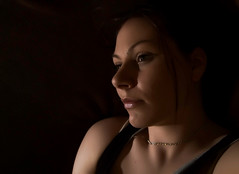Depth of field is created by a combination of aperture setting, focal length, and subject distance. We will start with aperture. If you have already completed the last assignment, you have seen for yourself the effects that the aperture setting will have on the DOF. Below you will see in a few quick examples the effect of just changing the aperture.





These shots were taken at 17mm in a range from 1st to last: f/16 f/11 f/8 f/4 &f/2.8. No flash approx 1 foot away from subject, the 1st silver candle.
Most of us already know a larger aperture will give us a shallow DOF. If you want to get a blurred background you need to open up the lens. But now we need to learn how to control the amount of DOF.
So how can you determine the DOF before taking the photo? Well, I will not complicate things by going into the Circle of Confusion(COF). Many wonderful people have put together a simple DOF calculator. Here is one for example; http://www.dofmaster.com/dofjs.html
Take for example my last shot at 17mm f/2.8:

This now tells me how much distance I will have in focus.It's the total under depth of field on the right; .11ft or 3.3cm. Why do I care? Let's say we're taking portraits. I want a shot of a child where the eyes and facial features are in sharp focus but I want a soft edge to the hair fading into the blurred background. I'll use this calculator to determine what settings I need to achieve this effect.
Hyperfocal distance is very important in landscape photography. This is the point at witch everything from half the hyperfocal distance to infinity will be in focus. Probably a bit confusing huh?
Example, (NOTE:SUBJECT DISTANCE DOES NOT EFFECT HYPERFOCAL DISTANCE)
Say I'm photographing a landscape scene with many subjects at different distances(houses, trees, mountains). With the above settings of 17mm at f/2.8 the hyperfocal distance is 16.8ft. If I focus at 16.8 feet, everything from approx 8ft in the foreground to infinity will be in focus.
Give it a try! Think of an effect you want with the DOF & your subject. How much of a DOF do you want? Choose your focal length and subject distance in the calculator and then look at the effects of changing apertures in the total for depth of field in the caluclator, that will be you area in focus. Find the aperture that will give you the amount of DOF you want, and shoot! Don't forget to adjust the shutter speed to give you a good exposure.

